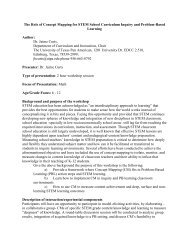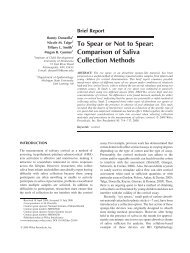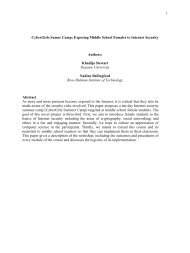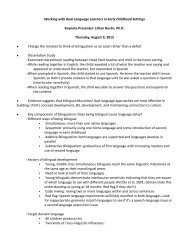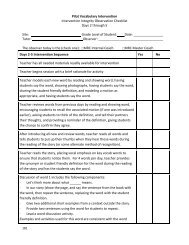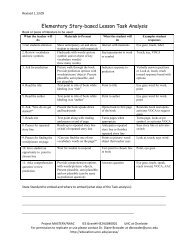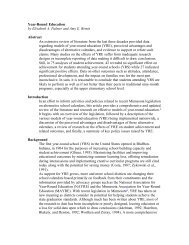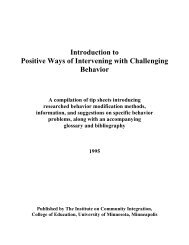Trauma and the Developing Brain - College of Education & Human ...
Trauma and the Developing Brain - College of Education & Human ...
Trauma and the Developing Brain - College of Education & Human ...
You also want an ePaper? Increase the reach of your titles
YUMPU automatically turns print PDFs into web optimized ePapers that Google loves.
H<strong>and</strong>out for <strong>Trauma</strong>, The <strong>Developing</strong> <strong>Brain</strong>, Healing <strong>and</strong> Emotional Regulation Seminars<br />
Karina A. Forrest-‐Perkins MHR LADC, 2011<br />
These changes in <strong>the</strong> central nervous system cause hypervigilance; under threat, <strong>the</strong> child tunes<br />
out all non-‐critical information. These actions prepare <strong>the</strong> child to do battle with or run away<br />
from <strong>the</strong> potential threat.<br />
This total body mobilization -‐-‐ <strong>the</strong> fight-‐or-‐flight response -‐-‐ has been well characterized <strong>and</strong><br />
described in great detail for adults. These responses are highly adaptive <strong>and</strong> involve many<br />
coordinated <strong>and</strong> integrated neurophysiological responses across multiple brain areas, including<br />
<strong>the</strong> brainstem nuclei responsible for autonomic nervous system regulation.<br />
What Does Hyperarousal Really Mean?<br />
Hyperarousal is a multi-‐dimensional process characterized by both mental <strong>and</strong> physical<br />
changes. These include an increase in <strong>the</strong> activity <strong>of</strong> those parts <strong>of</strong> <strong>the</strong> central <strong>and</strong> peripheral<br />
nervous system responsible for <strong>the</strong> perception <strong>and</strong> processing <strong>of</strong> potentially threatening<br />
information . This graded response also involves action.<br />
During <strong>the</strong> hyperarousal process, many physiological systems required for survival are activated<br />
(e.g., stress response hormones such as cortisol <strong>and</strong> adrenaline). The many physiological<br />
changes during hyperarousal will influence <strong>the</strong> way a person thinks, feels, <strong>and</strong> acts.<br />
The Psychology <strong>and</strong> Physiology <strong>of</strong> <strong>Trauma</strong><br />
The fight-‐or-‐flight response is a well-‐characterized reaction to danger, as we've already<br />
discussed. A second common reaction pattern to threat is dissociation. Dissociation is <strong>the</strong><br />
mental mechanism by which one withdraws attention from <strong>the</strong> outside world <strong>and</strong> focuses on<br />
<strong>the</strong> inner world.<br />
It is increasingly clear that responses to threat can vary tremendously from individual to<br />
individual. This second major adaptation response to threat involves an entirely different set <strong>of</strong><br />
physiological <strong>and</strong> mental changes, yet does not fall under <strong>the</strong> heading <strong>of</strong> ei<strong>the</strong>r fight or flight.<br />
Many common <strong>and</strong> "normal" mental <strong>and</strong> emotional states such as anxiety, dissociation, or<br />
anger are experienced by most <strong>of</strong> us to some degree. When any one <strong>of</strong> <strong>the</strong>se becomes<br />
pervasive <strong>and</strong> ever-‐present, however, it begins to interfere with <strong>the</strong> rest <strong>of</strong> one's life. This can<br />
happen with dissociation <strong>and</strong> anxiety. When it does wBecause <strong>of</strong> <strong>the</strong>ir small size <strong>and</strong> limited<br />
physical capabilities, young children do not usually have <strong>the</strong> fight-‐or-‐flight option in a<br />
threatening situation. When fighting or physically fleeing is not possible, <strong>the</strong> child may use<br />
avoidant <strong>and</strong> psychological fleeing mechanisms that are categorized as dissociative.<br />
Dissociation due to threat <strong>and</strong>/or trauma may involve a distorted sense <strong>of</strong> time or a detached<br />
feeling that you are observing something happen to you as if it is unreal -‐-‐ <strong>the</strong> sense that you<br />
may be watching a movie <strong>of</strong> your life. In extreme cases, children may withdraw into an<br />
elaborate fantasy world where <strong>the</strong>y may assume special powers or strengths.<br />
20




